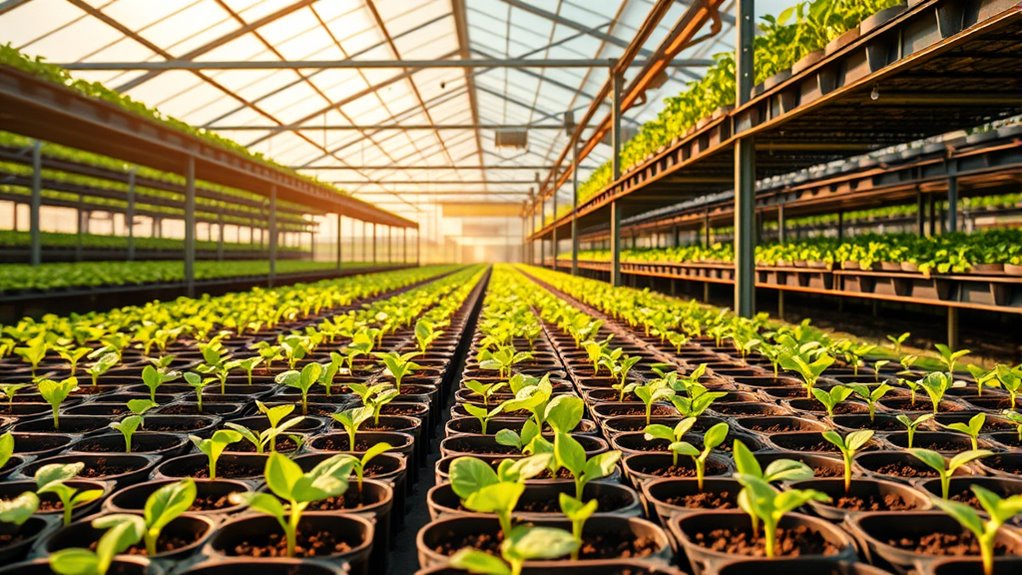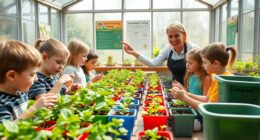Starting seeds in a greenhouse gives you a jump on spring by creating a warm, controlled space that fosters strong early growth and shields seedlings from pests and harsh weather. It allows you to prepare healthy, vigorous plants ahead of outdoor planting, extending your growing season. Proper soil preparation, moisture management, and good airflow are essential for success. If you keep these factors in mind, you’ll set yourself up for a healthy start—continue to explore for more tips and tricks.
Key Takeaways
- Use a warm, controlled greenhouse environment to start seeds early and extend the growing season.
- Prepare high-quality, well-draining soil with organic matter for healthy seedling growth.
- Maintain proper soil moisture and monitor environmental conditions regularly for optimal development.
- Ensure good ventilation with vents or fans to regulate humidity, temperature, and prevent diseases.
- Consistently manage watering and airflow to support vigorous seedlings and reduce transplant shock.

Starting seeds in a greenhouse gives you a head start on the growing season by providing a warm, controlled environment for young plants to thrive. To make the most of this setup, you need to focus on soil preparation and greenhouse ventilation. Proper soil prep ensures your seedlings have the nutrients they need to grow strong, while good ventilation helps maintain ideal temperature and humidity levels, preventing diseases and promoting healthy development.
Begin by preparing the soil carefully. Use a high-quality seed-starting mix that drains well but still retains moisture. You can enhance this mix with compost or organic matter to boost fertility. Avoid using garden soil directly, as it’s often too heavy or may contain pests and diseases that can harm young plants. Before planting, loosen the soil to ensure good aeration, which supports root development. Check the pH level—most seedlings prefer a slightly acidic to neutral pH of about 6.0 to 7.0. Adjust the soil as needed with amendments, and thoroughly moisten it so it’s ready for planting. Proper soil preparation provides a healthy foundation, encouraging vigorous growth right from the start. Understanding local regulations can also influence the types of materials you can use in your greenhouse setup.
Start with high-quality, well-draining soil enriched with compost for healthy seedling growth.
Greenhouse ventilation plays an essential role in maintaining a stable environment. Even in a heated greenhouse, airflow helps regulate temperature fluctuations and reduces humidity, which can otherwise lead to fungal issues or damping-off disease. Use vents, fans, or windows to promote air circulation, especially during the day when temperatures rise. At night, ensure ventilation isn’t too strong to avoid chilling your seedlings. Monitoring and adjusting airflow prevents the buildup of excess moisture, which can promote mold growth. Good ventilation also replenishes carbon dioxide levels, supporting photosynthesis and overall plant health. As your seedlings grow, keep an eye on humidity; too high and you risk disease, too low and your plants may dry out. By controlling these factors, you set a stable environment that encourages strong root and shoot development.
As you start your seeds, remember that soil preparation and ventilation are ongoing processes. Regularly check your soil moisture and adjust watering accordingly—keep it moist but not waterlogged. Also, keep an eye on the ventilation system, ensuring it remains effective as weather conditions change. With careful attention to these details, you’ll create an ideal environment for your seedlings to flourish early in the season. This proactive approach saves you time later, as healthier seedlings require less transplant shock and grow more vigorously once moved outdoors. Proper soil and airflow management truly set the foundation for a successful, bountiful garden.
Frequently Asked Questions
What Are the Best Temperature Ranges for Seed Germination?
You should keep your greenhouse temperature between 65-75°F for essential seed germination. This range encourages healthy seedling nutrition and prevents damping-off disease. Proper greenhouse ventilation helps maintain consistent temperatures and humidity levels, reducing risks of mold or fungal issues. Monitoring soil temperature is also vital—most seeds germinate best when the soil is around 60-70°F. Keep conditions stable for strong, healthy seedlings that thrive once transplanted.
How Often Should I Water Seedlings in a Greenhouse?
Did you know that over 80% of seedling failures are due to improper watering? You should water your seedlings in the greenhouse when the top layer of soil feels dry, usually every 1-3 days. Maintain humidity control by avoiding overwatering, which can cause damping-off disease. Keep a consistent watering frequency to promote healthy growth, ensuring your seedlings develop strong roots without becoming waterlogged.
What Type of Soil Mix Is Ideal for Seed Starting?
You should use a light, well-draining soil mix for seed starting in your seedling containers. Opt for a mix rich in soil nutrients that promotes healthy root growth and prevents waterlogging. A blend of peat moss, vermiculite, or perlite provides ideal aeration and moisture retention. This guarantees your seedlings get the right environment to thrive early on, setting a strong foundation for healthy growth.
How Can I Prevent Damping-Off Disease in Seedlings?
To prevent damping-off disease, make sure you sterilize your soil before planting, which kills harmful fungi. Use soil sterilization methods like baking in the oven or steaming. Additionally, apply a fungicide to your seed-starting mix to further protect seedlings. Keep the environment well-ventilated and avoid overwatering, as damp conditions promote fungal growth. These steps will help your seedlings stay healthy and thrive.
When Should I Transplant Seedlings Outdoors?
You should transplant your seedlings outdoors once they’ve developed strong, healthy roots and are at least 2-3 inches tall, usually after the last frost date. Don’t worry if indoor lighting isn’t perfect; just guarantee they’re well-hardened first. Proper seedling spacing during transplanting helps prevent disease and promotes growth. Wait until the weather warms up and the soil is workable, giving your plants the best start outside.
Conclusion
Starting your seeds in a greenhouse is like planting the first seeds of a vibrant garden dream. With a little extra care and patience, you’ll nurture tiny sprouts into a lush, thriving landscape. Think of it as opening a treasure chest filled with endless possibilities—each sprout a gem waiting to shine. So, get your greenhouse ready and let your gardening journey blossom, turning spring’s promise into a beautiful reality.








